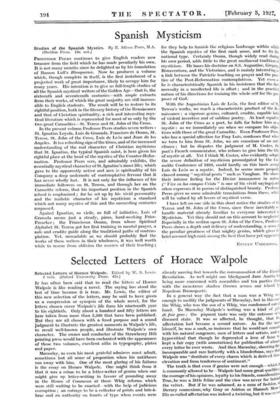Spanish Mysticism
Studies of the Spanish Mystics. By E. Allison Peers, M.A. (Sheldon Press. 18s. net.) Studies of the Spanish Mystics. By E. Allison Peers, M.A. (Sheldon Press. 18s. net.)
PROFESSOR PEERS continues to give English readers new treasure from the field which he has made peculiarly his own. It is not many months since he delighted us by his translation of Ramon Lull's Blanquerna. Now he produces a volume which, though complete in itself, is the first instalment of a projected work of great importance, likely to occupy him for many years. His intention is to give us full-length studies of . all the Spanish mystical writers of the Golden Age—that is, the sixteenth and seventeenth centuries—with ample extracts from their works, of which the great majority are still inacces- sible to English students. The result will be to restore to its rightful position, both in the literary history of the Renaissance and that of Christian spirituality, a rich and interesting mys- tical literature which is represented for most of us only by the two great Carmelites—St. Teresa and St. John of the Cross.
In the present volume Professor Peers studies seven writers : . St. Ignatius Loyola, Luis de Granada, Francisco de Osuna, St. Teresa, St. John of the Cross, Luis de LeOn and Juan de los Angeles. It is a refreshing sign of the tidies, and of the increased understanding of the real character of Christian myticisnas that St. Ignatius, the typical Spanish saint, is here given his rightful place at the head of the mystics of the Counter-Refor- mation. Professor Peers sees, and admirably exhibits, the essentially mystical character of St. Ignatius's inner life ; which gave to the apparently active and asee.ic spirituality of his Company a deep undernote of contemplative fervour that it has never wholly lost. It is not only for the influence of his immediate followers on St. Teresa, and through. her on the Carmelite reform, that his important position in the Spanish school is emphasized ; for lie set up by his vivid personality and the realistic character of his mysticism a standard which not many mystics of this and the succeeding centuries surpassed.
Against Ignatius, so virile, so full of initiative, Luis of Granada seems just a steady, pious, hard-working Friar- . Preacher ; the Franciscan Osuna, from whose Spiritual Alphabet St. Teresa got her first training in mental prayer, a safe and erudite guide along the traditional paths of contem- plation. Yet, unreadable as we should probably find the works of these writers in their wholeness, it was well worth while to rescue from oblivion the essence of their teaching ;
for they help to furnish the religious landscape within which the Spanish mystics of the first rank arose, and to fix the national type. Certainly Osuna, though' widely read dm* his own period, adds little to the great inediacvai tradition oi mysticism. He bases his doctrine on S.S. Augustine, Creg,ary, Eonaventura, and the Victorines, and is mainly interesting as a link between the Patristic teaching on prayer and the prae. tice of the Post-Reformation contemplatives. Yet even sn he is characteristically Spanish in his insistence that the first necessity in a recollected life: is effort ; and in the practical nature of his directions for training the whole self for the pur. poses of God.
With the Augustinian Luis de Ledn, the first editor of St, Teresa's works, we reach a characteristic product- of the fie. naissance : a vigorous genius, cultured, erudite, capable both of Violent invective and of sublime poetry. At least equal ti St. John of the Cross as a poet, he falls far below him as a mystic: as we immediately see when we compare his objee. tives with those of the great Carmelite. 'Even Professor Peers., who has a special affection for Fray Luis, confesses that when we turn to him from St. John, we are conscious of an anti. climax ; but he disputes the judgment of M. Coster, tire poet's French commentator, who refuses to give him the titk of mystic at all. Yet I think M. Coster, who evidently adopts the severe definition of mysticism promulgated by the Car. melite Conference of 1923, could hardly on this basis accept Luis de Leon as a mystic. Indeed, he seems more properly classed among "mystical poets" such as Vaughan. He slum their intense feeling for the Divine immanence in nature (" Vive en los canapos Cristo" is one of his vivid sayings) and often expresses it in poems of distinguished beauty. Professol Peers gives us some admirable translations from these, which win be valued by all lovers of mystical verse.
I have left on one side in this short notice the studies of St. Teresa and St. John of the Cross, since these inevitably re. handle material already familiar to everyone interested in Mysticism. Yet they should not on this account be neglected. Especially in the section upon St. John of the Cross, Professor Peers shows a depth and delicacy of understanding, a sense of the peculiar greatness of that mighty genius, which gives hi brief account high rank among the bestthat have yet appeared.
EVELYN LTN-DEn /111.L.


























































 Previous page
Previous page